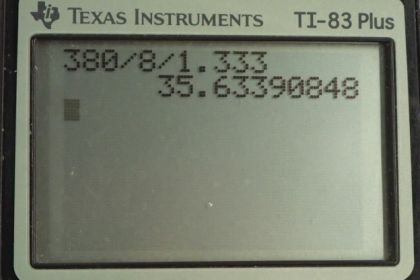Question
(a) As a soap bubble thins it becomes dark, because the path length difference becomes small compared with the wavelength of light and there is a phase shift at the top surface. If it becomes dark when the path length difference is less than one-fourth the wavelength, what is the thickest the bubble can be and appear dark at all visible wavelengths? Assume the same index of refraction as water. (b) Discuss the fragility of the film considering the thickness found.
Final Answer
- The soap bubble will pop with the slightest breeze.
Solution video
OpenStax College Physics for AP® Courses, Chapter 27, Problem 77 (Problems & Exercises)

vote with a rating of
votes with an average rating of
.
Calculator Screenshots
Video Transcript
This is College Physics Answers with Shaun Dychko. This soap bubble that has an index of refraction of 1.33 the same as water is very thin and it's so thin that it will appear black because there will be destructive interference for all the different wavelengths when it's so thin. Because this path length difference won't be enough to cause constructive interference for any of the colors. And so there will be only destructive interference because this reflection at this interface between the air and the soap bubble was going to be phase shifted by lambda over two because it's going from a medium of low index of refraction 1.0 to a medium of high index of refraction 1.33 . So this pie over two phase shift occurs here and the path length difference due to Ray two travelling through the slope filming then reflecting off the bottom side of it that path length difference is not enough to cause any constructive interference. And so there will be only destructive interference this path length difference is insignificant. And so the phase difference between these two rays is essentially pie over two the phase shit due to Ray one. Now this path length difference is insignificant if it is less than a quarter of the wavelength we're told in the question. And so we need to make an expression for what this path length difference is and then we'll set it equal to a quarter of the wavelength. So path length difference which is a phase shift for Ray two is going to be 2 times the thickness and I have two times there because the ray goes once the thickness and then a second time back up and this fraction is the number of wavelengths. That's the number of lambdas because I'm dividing that total distance by the number of nanometres per wavelength. And so that gives the number of wavelengths and this is the wavelength within the soap bubble material. So that's why there's a subscript n there. To say that this is the wavelength in this medium of index refraction n and we have an expression for that wavelength n is the wavelength in a vacuum or air because air’s index of refraction is close enough to that of a vacuum divided by the index refraction n . And so having lambda divided by n is what this is. And dividing by it means multiplied by its reciprocal. So that's why multiplying by n over lambda here and at this point the lambda cancel. And the reason we're multiplying by lambda here s because this fraction gives us the number of lambdas and we're multiplying by the number of nanometres per lambda. And so for one lambda and then these lambdas cancel n little nanometres and so that gives us a path length difference and that expression for that then in the end is two times the thickness times the index of refraction of the soap film. Now all of this is meant to equal the wavelength divided by four. Now the question says it shall be dark for all visible wavelengths and so we get to choose which wavelength to use there. And since we want to know what is the maximum possible thickness that it could have. We're going to choose the minimum visible wavelength. And so this is going to be the wavelength of Violet that we put there. If we had chosen red there then it's still possible for Violet to have constructive interference. So anyway so we're finding the maximum possible thickness of this soap film can have such that every single visible wavelength will appear black. So now we rearrange this by dividing both sides by 2n and we get lambda minimum over eight times index refraction is the maximum thickness that this bubble can have and still have the appearance of Black. So it’s 380 nanometres divided by eight times 1.333 which is 35.6 nanometres. Now that is a very thin bubble. And so it's going to pop with the slightest breeze.
